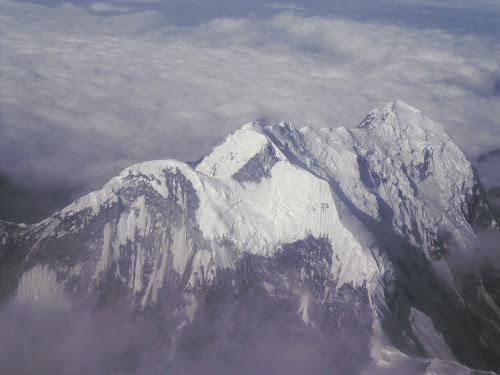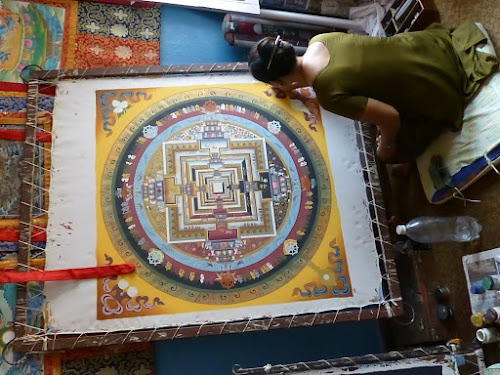Yesterday on our bus ride into Kathmandu our tour leader Steve asked us if we would like to try to get tickets for the daily sightseeing flight around Mount Everest...seeing as how we missed out on seeing Everest up close and personal from base camp, we and Ted and Neil all jumped at the chance. So Steve worked his magic and got us all lined up to take an early flight to go see Everest eye to eye. We will get this flight in before we meet up with the rest of our group for the rest of the day's sightseeing.
So we rise early, have our coffee, and get to the airport for a 6:30am flight. The domestic terminal in Kathmandu is, well, understated...but we're ready to go...
This is our plane...and yes, that says Yeti Airlines...so we get onboard and buckle up.
It is a very hazy morning and we sit at the airport wondering if we will be able to get off the ground, and if so will we see the mountain...as we take off and climb above Kathmandu it is so hazy that we lose sight of the ground at about 1,500 feet. We climb fairly quickly and before you know it we are above the clouds and heading right straight for Mount Everest! We get some great shots of Everest and several other peaks...far more than you could stand in this single post...so here are a few to give you an idea of how majestic the Himalayas are from the air...
We sent Ted outside to get a picture of us looking out of the windows of the plane at Mount Everest...he had the best camera...and he is the oldest...
That was great! We are all very happy to have had the chance to see Everest up close...though I think that our two bachelor friends have already turned their attention the flight attendant...
The four Everest aviators return to the ground and return to the hotel for breakfast and to rejoin the others. On the way back we see an interesting restaurant that must cater to men...anyhooooo....
Our first destination for today is the Boudhanath...it is one of the holiest sites in Kathmandu and is a UNESCO World Heritage site. This massive stupa is almost 120 feet high, and it does not contain any interior space...that whole thing is solid. We walk around the Boudhanath, spinning the prayer wheels that ring its exterior wall, then we climb the steps and walk around the first layer. The stupa is designed like a huge mandala with several layers, and at the center is the tower that is covered in gold and has huge eyes painted on the base where it emerges from the white dome. Not too long ago, the Boudhanath was out in the middle of farm fields, and now there are buildings and shops encircling the huge stupa.
On one side of the plaza surrounding the Boudhanath is a monastery
While we were making our way around the inside of the monastery's main assembly hall, the monks reached a particular place in their prayer where they added music, so all of a sudden this cacophony of horns and drums erupted...
One of the shops adjacent to the Boudhanath is a workshop where artists are creating thangkas with mandala patterns and other common Buddhist images. The thangkas are of varying size and quality...those made by accomplished artists have the most amazing level of detail in the painting as well as the application of gold leaf. We get an opportunity to see the artists in action...this lady is working on a large mandala thangka...the mandala is the geometric shape that is what the Boudhanath would look like if you were to look down from directly above it...
Back out on the street we see the typical crazy Kathmandu traffic...cars, motorcycles, bicycles, pedestrians, three-wheel cabs, and, of course, the usual sacred cow laying on the sidewalk...
Our second stop for the day is the Pashupatinath, the Hindu temple and cremation site in Kathmandu. This place is rather surreal...it is a long building that looks something like an early 19th century train station with covered platforms, and a large temple is attached at the far end. But there are no train tracks, just the shallow remains of the Bagmati river alongside the raised platform. Monkeys roam the grounds, and a small herd of (sacred) cows hang out in the river bed.
Hindus in Nepal are required to cremate the body of a family member very quickly after death, usually within a couple of hours, so on any given day there is a steady stream of bodies arriving to be cremated. The location adjacent to the river is important, it is considered a sacred river and eventually winds its way to the Ganges which is a sacred river in India. There are stairs next to each cremation platform so that the family can immerse the body in the river before offering it up for cremation. Cremation is done in an open air fashion, with the body wrapped in cloth and placed on top of a large stack of wood. The family members generally wait while the body is consumed by the flames.
We stood across the river from the cremation platforms and learned about this Hindu ritual, then we walked around to look at the small votive shrines on our side of the river.
We turned a corner at the top of some stairs and we spied these guys...sadhus...a little explanation is needed...Sadhus are individuals who have renounced all worldly attachments as a way to help them achieve the fourth and final stage of enlightenment.
We figured we need all the enlightenment we can get so we decided to hang out with the guys for a while...they put a little red powder on our foreheads and shared some of their learnings. Michael had a bit of an OMG moment when the guy on his right decided to put his five feet of dreadlocks around Michael's neck...but the whole time he was chanting little prayers like "safe travels, safe journey" and "long life" and patted Michael on the head...OK, that's enough enlightenment...time to move on!
This is the temple at Pashupatinath which non-Hindus are barred from entering. This is a pattern in Nepal; at several Hindu temples there are large signs prohibiting anyone who is not Hindu from entering...and in this part of the world that really comes down to skin color (a Buddhist with dark skin can waltz right in...but with our light skin we don't stand a chance).
Our final stop of the day is the site of the old royal palace. Here we get a look at the architecture and design elements of past centuries in Nepal. Nepal was ruled by a royal family from the mid-1700's until 2005 when the dynasty came to a very strange end...the prince killed his parents and became king, but he was only king for one day. He committed suicide and died three days later. The prince's uncle took the throne, dismissed the legislature and tried to squash the Maoists, but the Maoists eventually forced the king to step down and they took over in 2005.
A few words about Nepal, which is a country that is not very close to having its act together...first, the time in Nepal is 15 minutes different than every other time zone in the region (no reason, really...); second, the city experiences rolling blackouts for large portions of the year, and residents will go without electricity for up to 16 hours a day; you cannot drink water from the tap without getting sick; and the government just failed to draft a new constitution (after three continuances) so it was disbanded, with the Prime Minister now standing as the one person caretaker of the country...so as you can see, there are some challenges...the challenges extend all the way down the line...this is an active fire department in Kathmandu...
As we enter the square, we see a sign for the street made famous by the hippies who came to Nepal in the 1960's to drop out and do drugs...
We thought we'd share some views of the palace, the square, and some of the amazingly intricate and extensive wood carving that adorns the temples and palace pavilions...
At one point, we enter this small courtyard and learn that we are in the temple of the Kumari...this really needs some explanation. In Nepal there is a tradition of selecting a very young girl as the incarnation of the divine female energy. This is a Hindu practice, but in many places the young girl is only selected for a day, but here she is sequestered as the Kumari until she reaches puberty. She lives here alone with her teachers, and then when she reaches puberty she is returned to her family and becomes just another Nepali woman. The Kumari here in Kathmandu is selected from among the Nawari clan, the valley's original inhabitants.
Just a few more photos of all the carvings and ornamentation...it was kind of overwhelming...
We took a walk through the market streets to get a feel for the local activity...
It's hard to believe they have power problems with top-notch professional wiring work like this...!
It has been long, exciting, hot day, so Happy Hour is most welcome as the next activity on our itinerary...
For dinner, Steve takes us to a rooftop Thai restaurant in the Thamel district. Thamel is a market area that is very much like a maze and packed with shops of all sorts, most catering to tourists looking for trinkets or cheap knock-offs of North Face hiking gear and clothes. It was still warm in the evening, but the rooftop location elevated us above the noise and chaos of the streets below and made for a great evening together.
After dinner, we retire to the Shangri-La and recharge for our next day of sightseeing in Kathmandu...what a crazy city!






























































The photos of Mount Everest from the air are so beautiful!!!
ReplyDeleteLoving the picture of Uncle Mike with that guy's hair wrapped around him. Hilarious!
...I'm still scrubbing my neck...
Delete